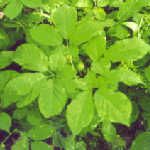| Common Name: |
Paratuda |
| Other Names: |
Suma, Pfaffia, Brazilian Ginseng, corang-acu. |
| Botanical Name: |
Pfaffia paniculata syn. Gomphrena paniculata, Hebanthe paniculata, Iresine erianthos. |
| Genus: |
Pfaffia |
| Family: |
Amaranthaceae |
| Native Location: |
Rainforests in Brazil, Ecuador, Paraguay and Peru: also in Panama, possibly introduced rather than native. |
| Cultivation: |
Appears to be wild collected, as no references have been found on its cultivation. |
| Propagation: |
Appears to be wild collected, as no references have been found on its cultivation. |
| Harvest: |
Roots are collected from mature plants, about 7 years old, and dried for decoctions, powder and tablets. |
| Height: |
2-3m (6-10ft) |
| Hardiness: |
Min. 15°C (59°F) |
| Parts Used: |
Roots |
| Properties: |
A tonic, sedative, analgesic herb that lowers blood sugar and cholesterol levels, and has hormonal, tissue-healing, and anti-inflammatory effects. It is an adaptogen and immune stimulant, and is reputedly aphrodisiac. |
| Medicinal Uses: |
Internally for stress, chronic fatique, debility, poor appetite, Epstein-Barr disease, mononucleosis (glandular fever), infertility, impotence, menstrual and menopausal problems, diabetes, pancreas dysfuntion, ulcers, rheumatism, osteomyelitis, hypertension, cardiovascular disease, nervous disorders, chronic degenerative diseases, and various kinds of cancer. Also to improve resistance to infection and increase stamina. Internally and externally for wounds and fractures. |
| Economic Uses: |
Extracts are added to food supplements and herbal tonics. |
| Bibliography: |
Encyclopedia of Herbs by Deni Brown Copyright © 1995, 2001 Dorling Kindersley Limited. Pg 311 |

